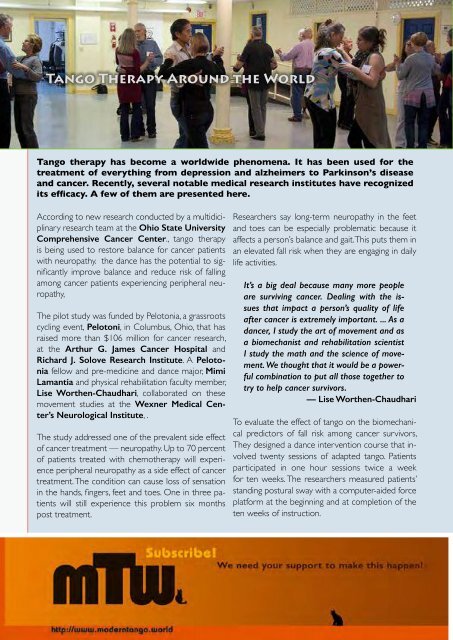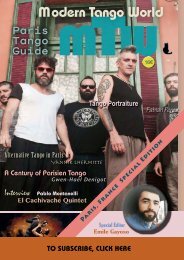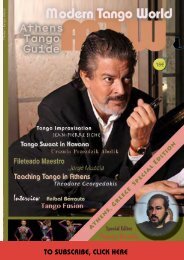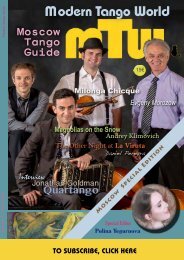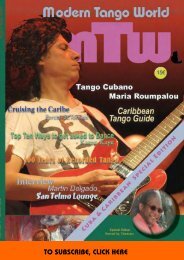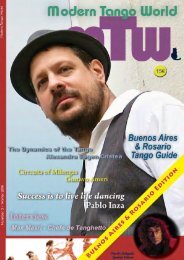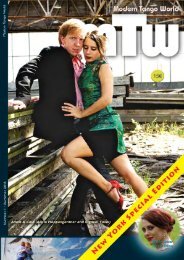Modern Tango World #5 (Mexico)
Mexico Special Features Milongas in the Park Roberto González 3 Snapshot of the Mexican Music Scene Miguel Garcia 6 A New Generation Mauricio Salvador 12 Guide to Tango in Mexico 16 Visual Tango Poems Murat Erdemsel 22 Interview with Plaza Francia Marco Buso 26 Tango Therapy Around the World 30 Movie Review: Tango Pasion Alexandru Eugen Cristea 33 New Tango Music Arndt Büssing 34 Horacio Salgan: Tango Giant 38 DJ/VJ-ing - A VJ Manifesto Zarah Cabanas 40 Tango Moves: caminando Raymond Lauzzana 44 Letters to the Editor 47
Mexico Special Features
Milongas in the Park Roberto González 3
Snapshot of the Mexican Music Scene Miguel Garcia 6
A New Generation Mauricio Salvador 12
Guide to Tango in Mexico 16
Visual Tango Poems Murat Erdemsel 22
Interview with Plaza Francia Marco Buso 26
Tango Therapy Around the World 30
Movie Review: Tango Pasion Alexandru Eugen Cristea 33
New Tango Music Arndt Büssing 34
Horacio Salgan: Tango Giant 38
DJ/VJ-ing - A VJ Manifesto Zarah Cabanas 40
Tango Moves: caminando Raymond Lauzzana 44
Letters to the Editor 47
Create successful ePaper yourself
Turn your PDF publications into a flip-book with our unique Google optimized e-Paper software.
.<strong>Tango</strong> Therapy Around the <strong>World</strong><br />
<strong>Tango</strong> therapy has become a worldwide phenomena. It has been used for the<br />
treatment of everything from depression and alzheimers to Parkinson’s disease<br />
and cancer. Recently, several notable medical research institutes have recognized<br />
its efficacy. A few of them are presented here.<br />
According to new research conducted by a multidiciplinary<br />
research team at the Ohio State University<br />
Comprehensive Cancer Center., tango therapy<br />
is being used to restore balance for cancer patients<br />
with neuropathy. the dance has the potential to significantly<br />
improve balance and reduce risk of falling<br />
among cancer patients experiencing peripheral neuropathy,<br />
The pilot study was funded by Pelotonia, a grassroots<br />
cycling event, Pelotoni, in Columbus, Ohio, that has<br />
raised more than $106 million for cancer research,<br />
at the Arthur G. James Cancer Hospital and<br />
Richard J. Solove Research Institute. A Pelotonia<br />
fellow and pre-medicine and dance major, Mimi<br />
Lamantia and physical rehabilitation faculty member,<br />
Lise Worthen-Chaudhari, collaborated on these<br />
movement studies at the Wexner Medical Center’s<br />
Neurological Institute, .<br />
The study addressed one of the prevalent side effect<br />
of cancer treatment — neuropathy. Up to 70 percent<br />
of patients treated with chemotherapy will experience<br />
peripheral neuropathy as a side effect of cancer<br />
treatment. The condition can cause loss of sensation<br />
in the hands, fingers, feet and toes. One in three patients<br />
will still experience this problem six months<br />
post treatment.<br />
Researchers say long-term neuropathy in the feet<br />
and toes can be especially problematic because it<br />
affects a person’s balance and gait. This puts them in<br />
an elevated fall risk when they are engaging in daily<br />
life activities.<br />
It’s a big deal because many more people<br />
are surviving cancer. Dealing with the issues<br />
that impact a person’s quality of life<br />
after cancer is extremely important. ... As a<br />
dancer, I study the art of movement and as<br />
a biomechanist and rehabilitation scientist<br />
I study the math and the science of movement.<br />
We thought that it would be a powerful<br />
combination to put all those together to<br />
try to help cancer survivors.<br />
— Lise Worthen-Chaudhari<br />
To evaluate the effect of tango on the biomechanical<br />
predictors of fall risk among cancer survivors,<br />
They designed a dance intervention course that involved<br />
twenty sessions of adapted tango. Patients<br />
participated in one hour sessions twice a week<br />
for ten weeks. The researchers measured patients’<br />
standing postural sway with a computer-aided force<br />
platform at the beginning and at completion of the<br />
ten weeks of instruction.<br />
— 30 —


